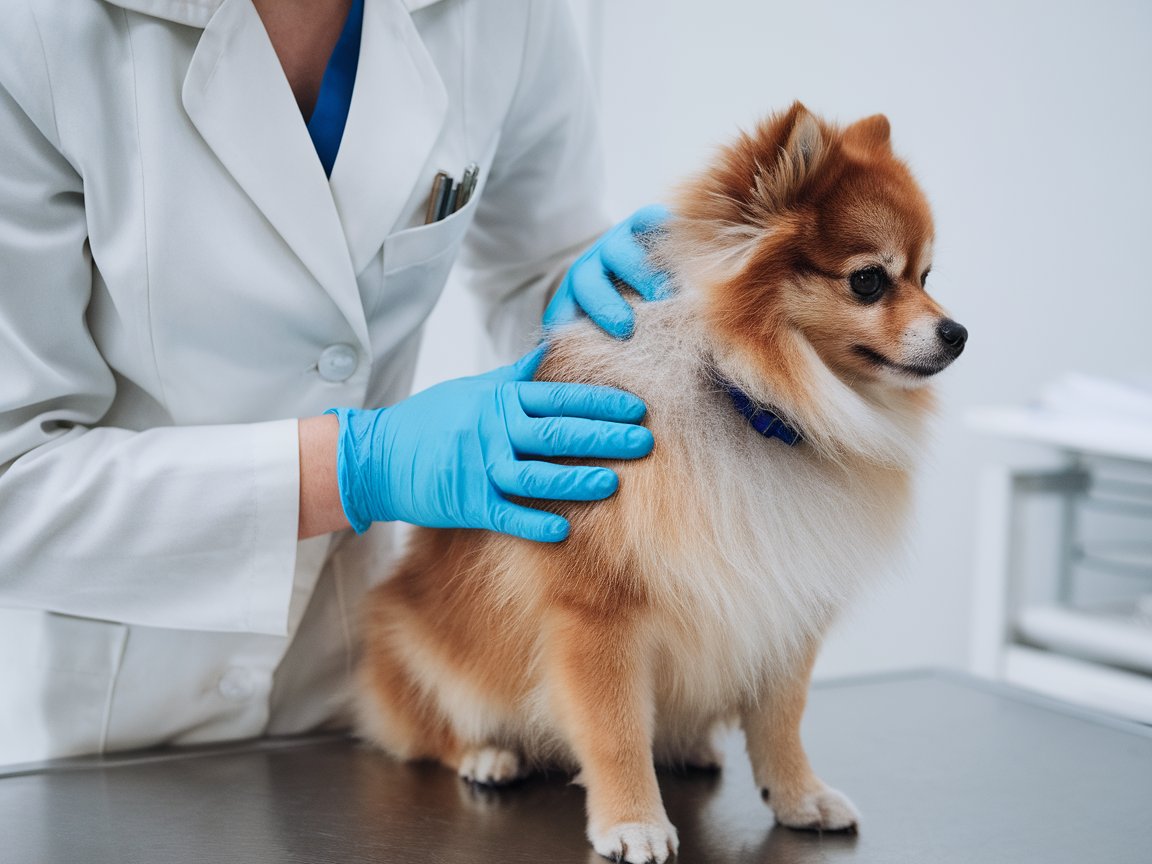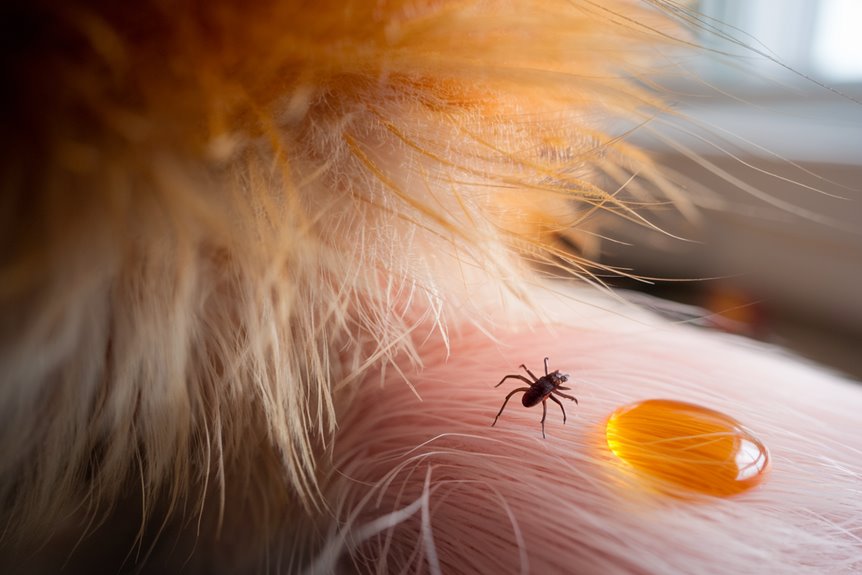Looking after your Pom’s flea and tick problem needs special attention since these little pups are so tiny! You’ll want to keep an eye out for them scratching more than usual, those pesky black spots in their fur, or if their skin looks irritated. Just remember – don’t grab any old flea treatment if your Pom weighs under 20 pounds or is younger than 3 years old, as these small pups are super sensitive. Natural stuff works great – try mixing some brewer’s yeast into their food or using essential oils. Your best bet is staying on top of brushing their coat, keeping your yard tidy, and making sure your house is clean. Once you get the hang of protecting your little buddy from these pests, they’ll be much happier and comfier!
Health Risks to Pomeranians

Dealing with fleas and ticks can be super tricky if you’ve got a Pomeranian!
These little fluffballs are really sensitive to regular flea treatments, especially the tiny ones under 20 pounds or pups under three years old. Heart disease symptoms often worsen with severe flea and tick infestations.
Keep your eyes peeled when using chemical stuff – your Pom might show signs that something’s not right. They could throw up, get the runs, or start drooling like crazy.
You might also spot their skin getting red and irritated, or notice patches of fur falling out. One female flea can lay up to 50 eggs each day, making infestations spread quickly.
What’s really scary is when they start having seizures or tremors, which can happen if tick removal goes wrong or if the treatment doesn’t agree with them.
Don’t worry – you’re not the only one freaking out about this!
Lots of other Pom owners have found out that regular store-bought treatments can be pretty risky for their fur babies.
That’s why it’s super important to check with your vet first before trying any flea and tick stuff on your little buddy.
Spotting Signs of Infestation
Keep your eyes peeled for signs of fleas and ticks on your Pom – it’s super important to catch these little pests early before they cause real trouble.
Your pup will give you some obvious hints if something’s bugging them, like scratching like crazy, grooming non-stop, or acting all fidgety and uncomfortable.
When you’re giving your furry buddy their regular brush-out, look out for some telltale signs.
You might see what looks like black pepper scattered in their fur, especially around their neck, back, and tail – that’s actually flea poop!
If your Pom’s skin is all red and irritated, or they’ve got sore patches from scratching, that’s a big clue.
Fleas are tiny brown bugs that hop around super fast, while ticks are like little vampires that stick to your dog’s skin and leave nasty welts.
If you notice your pup’s gums looking pale or they seem really tired and lazy, get them to the vet right away – it could mean they’ve got a bad case of these unwanted guests.
Natural Prevention Methods

Natural stuff works great to keep those annoying fleas and ticks away from your Pom without using chemicals. You can try mixing some brewer’s yeast into their food, or use natural oils like lemongrass, peppermint, and citronella to make your pup less tasty to bugs.
Switching up what they eat and changing things around the house can really help too.
Want to bug-proof your place? Just sprinkle some diatomaceous earth inside and throw some cedar mulch in your yard.
Brush your Pom regularly and run a flea comb through their fur every day – it makes a huge difference!
Also, keep your yard tidy by cutting back bushes and cleaning up fallen leaves and stuff. These little tasks make it super hard for fleas and ticks to feel at home.
Just make sure to check with your vet before trying anything new with your furry friend.
Safe Chemical Treatment Options

Heading straight for strong flea and tick protection? Some natural remedies work, but your Pom might need something stronger to stay bug-free.
For chemical options, you’ve got topical treatments and flea collars to pick from. Products with permethrin or fipronil do a great job, but watch out – your tiny pup needs the right dose!
If you go with a chemical collar like Seresto, just make sure it sits snugly against their fur. Since Poms are such little fluff-balls, keep an eye on them to make sure they’re not having any bad reactions.
Best to check with your vet first before trying any chemical stuff, and hang onto those product instructions. If your pup starts acting weird, shaking, or throwing up, take the treatment off right away and call your vet.
Your little buddy’s health matters most!
Home and Yard Protection
Just keeping your home flea-free means getting tough both inside and out!
Make sure you vacuum like crazy, especially where your Pom hangs out – those sneaky flea eggs love hiding in furniture and carpets. Grab your pup’s bedding and toss it in hot water, and don’t forget to toss those vacuum bags out right away, or those pesky fleas might come back!
Your yard needs some love too if you want to keep your Pom safe. Cut that grass short and keep bushes trimmed – ticks hate that!
Throw down some gravel or mulch between your yard and wild areas to create a bug barrier. Want extra protection? Try natural stuff like Wondercide or sprinkle some diatomaceous earth around – they’ll knock out fleas and ticks without hurting your furry buddy.
Oh, and patch up any holes around your house so mice and rats can’t bring their flea friends to the party!
Frequently Asked Questions
Can Pomeranians Develop Immunity to Flea and Tick Bites Over Time?
Nope, your Pom won’t magically become immune to fleas and ticks just by getting bitten a lot. These pesky bugs will keep coming back for more, and your pup can’t fight them off naturally – no matter how many times they’re bitten. That’s why you’ll need to keep up with flea and tick treatments to keep your furry friend safe and comfy.
How Long Should I Wait Between Different Types of Flea Treatments?
Just remember to be super careful with your flea treatments! Let one treatment finish doing its job before jumping into a new one. Check the label to see how often you can use it, and it’s a good idea to run it by your vet to make sure you’re doing what’s best for your pet.
Do Fleas and Ticks Prefer Certain Colored Pomeranian Coats Over Others?
Guess what – your Pom’s fur color won’t make them more or less attractive to fleas and ticks! These pesky bugs don’t play favorites when it comes to coat colors – they’ll happily hop onto any fluffy pup they find. The truth is, these little parasites just want a warm, furry home, no matter what color it is!
What Temperature Kills Flea Eggs and Larvae in Washing Machines?
Hot water at 140°F (60°C) is what you need to get rid of those pesky fleas, eggs and all. Just toss your stuff in the washer at this temp and it’ll wipe out both the eggs and baby fleas. For the best results, make sure to blast everything in the dryer on high heat afterward.
Can Indoor-Only Pomeranians Still Get Fleas and Ticks?
Even if your pom never leaves the house, those little pests can still be a problem! Fleas and ticks are sneaky – they hitch rides on clothes, jump from other people, and even hide in used furniture. That’s exactly why your indoor fluff ball needs flea protection just like outdoor pets do. It might seem unnecessary, but trust me, it’s better to be safe than sorry!




